【Spring注解驱动开发】BeanPostProcessor在Spring底层是如何使用的?看完这篇我懂了!!
写在前面
在《【String注解驱动开发】面试官再问你BeanPostProcessor的执行流程,就把这篇文章甩给他!》一文中,我们详细的介绍了BeanPostProcessor的执行流程。那么,BeanPostProcessor在Spring底层是如何使用的?今天,我们就一起来探讨下Spring的源码,一探BeanPostProcessor在Spring底层的使用情况。
项目工程源码已经提交到GitHub:https://github.com/sunshinelyz/spring-annotation
BeanPostProcessor接口
我们先来看下BeanPostProcessor接口的源码,如下所示。
package org.springframework.beans.factory.config;
import org.springframework.beans.BeansException;
import org.springframework.lang.Nullable;
public interface BeanPostProcessor {
@Nullable
default Object postProcessBeforeInitialization(Object bean, String beanName) throws BeansException {
return bean;
}
@Nullable
default Object postProcessAfterInitialization(Object bean, String beanName) throws BeansException {
return bean;
}
}
可以看到,在BeanPostProcessor接口中,提供了两个方法:postProcessBeforeInitialization()方法和postProcessAfterInitialization()方法。postProcessBeforeInitialization()方法会在bean初始化之前调用,postProcessAfterInitialization()方法会在bean初始化之后调用。接下来,我们就分析下BeanPostProcessor接口在Spring中的实现。
注意:这里,我列举几个BeanPostProcessor接口在Spring中的实现类,来让大家更加清晰的理解BeanPostProcessor接口在Spring底层的应用。
ApplicationContextAwareProcessor类
org.springframework.context.support.ApplicationContextAwareProcessor是BeanPostProcessor接口的实现类,这个类的作用是可以向组件中注入IOC容器,大致的源码如下所示。
package org.springframework.context.support;
import java.security.AccessControlContext;
import java.security.AccessController;
import java.security.PrivilegedAction;
import org.springframework.beans.BeansException;
import org.springframework.beans.factory.config.BeanPostProcessor;
import org.springframework.beans.factory.config.EmbeddedValueResolver;
import org.springframework.context.ApplicationContextAware;
import org.springframework.context.ApplicationEventPublisherAware;
import org.springframework.context.ConfigurableApplicationContext;
import org.springframework.context.EmbeddedValueResolverAware;
import org.springframework.context.EnvironmentAware;
import org.springframework.context.MessageSourceAware;
import org.springframework.context.ResourceLoaderAware;
import org.springframework.lang.Nullable;
import org.springframework.util.StringValueResolver;
class ApplicationContextAwareProcessor implements BeanPostProcessor {
/****************************省略N多行代码************************/
}
这里,省略了源码的细节,只给出了类结构,感兴趣的小伙伴们可自行翻阅Spring源码进行查看,我这里的Spring版本为5.2.6.RELEASE。
那具体如何使用ApplicationContextAwareProcessor类向组件中注入IOC容器呢?别急,我用一个例子来说明下,相信小伙伴们看完后会有一种豁然开朗的感觉——哦,原来是它啊,我之前在项目中使用过的!
要想使用ApplicationContextAwareProcessor类向组件中注入IOC容器,我们就不得不提Spring中的另一个接口:ApplicationContextAware,如果需要向组件中注入IOC容器,可以使组件实现ApplicationContextAware接口。
例如,我们创建一个Employee类,使其实现ApplicationContextAware接口,此时,我们需要实现ApplicationContextAware接口的setApplicationContext()方法,在setApplicationContext()方法中有一个ApplicationContext类型的参数,这个就是IOC容器对象,我们可以在Employee类中定义一个ApplicationContext类型的成员变量,然后在setApplicationContext()方法中为这个成员变量赋值,此时就可以在Employee中的其他方法中使用ApplicationContext对象了,如下所示。
package io.mykit.spring.plugins.register.bean;
import org.springframework.beans.BeansException;
import org.springframework.context.ApplicationContext;
import org.springframework.context.ApplicationContextAware;
import org.springframework.stereotype.Component;
/**
* @author binghe
* @version 1.0.0
* @description 测试ApplicationContextAware
*/
@Component
public class Employee implements ApplicationContextAware {
private ApplicationContext applicationContext;
@Override
public void setApplicationContext(ApplicationContext applicationContext) throws BeansException {
this.applicationContext = applicationContext;
}
}
看到这里,相信不少小伙伴们都有一种很熟悉的感觉:没错,我之前也在项目中使用过!是的,这就是BeanPostProcessor在Spring底层的一种使用场景。至于上面的案例代码为何会在setApplicationContext()方法中获取到ApplicationContext对象,这就是ApplicationContextAwareProcessor类的功劳了!
接下来,我们就深入分析下ApplicationContextAwareProcessor类。
我们先来看下ApplicationContextAwareProcessor类中对于postProcessBeforeInitialization()方法的实现,如下所示。
@Override
@Nullable
public Object postProcessBeforeInitialization(Object bean, String beanName) throws BeansException {
if (!(bean instanceof EnvironmentAware || bean instanceof EmbeddedValueResolverAware ||
bean instanceof ResourceLoaderAware || bean instanceof ApplicationEventPublisherAware ||
bean instanceof MessageSourceAware || bean instanceof ApplicationContextAware)){
return bean;
}
AccessControlContext acc = null;
if (System.getSecurityManager() != null) {
acc = this.applicationContext.getBeanFactory().getAccessControlContext();
}
if (acc != null) {
AccessController.doPrivileged((PrivilegedAction<Object>) () -> {
invokeAwareInterfaces(bean);
return null;
}, acc);
}
else {
invokeAwareInterfaces(bean);
}
return bean;
}
在bean初始化之前,首先对当前bean的类型进行判断,如果当前bean的类型不是EnvironmentAware,不是EmbeddedValueResolverAware,不是ResourceLoaderAware,不是ApplicationEventPublisherAware,不是MessageSourceAware,也不是ApplicationContextAware,则直接返回bean。如果是上面类型中的一种类型,则最终会调用invokeAwareInterfaces()方法,并将bean传递给invokeAwareInterfaces()方法。invokeAwareInterfaces()方法又是个什么鬼呢?我们继续看invokeAwareInterfaces()方法的源码,如下所示。
private void invokeAwareInterfaces(Object bean) {
if (bean instanceof EnvironmentAware) {
((EnvironmentAware) bean).setEnvironment(this.applicationContext.getEnvironment());
}
if (bean instanceof EmbeddedValueResolverAware) {
((EmbeddedValueResolverAware) bean).setEmbeddedValueResolver(this.embeddedValueResolver);
}
if (bean instanceof ResourceLoaderAware) {
((ResourceLoaderAware) bean).setResourceLoader(this.applicationContext);
}
if (bean instanceof ApplicationEventPublisherAware) {
((ApplicationEventPublisherAware) bean).setApplicationEventPublisher(this.applicationContext);
}
if (bean instanceof MessageSourceAware) {
((MessageSourceAware) bean).setMessageSource(this.applicationContext);
}
if (bean instanceof ApplicationContextAware) {
((ApplicationContextAware) bean).setApplicationContext(this.applicationContext);
}
}
可以看到invokeAwareInterfaces()方法的源码比较简单,就是判断当前bean属于哪种接口类型,则将bean强转为哪种接口类型的对象,然后调用接口的方法,将相应的参数传递到接口的方法中。这里,我们在创建Employee类时,实现的是ApplicationContextAware接口,所以,在invokeAwareInterfaces()方法中,会执行如下的逻辑代码。
if (bean instanceof ApplicationContextAware) {
((ApplicationContextAware) bean).setApplicationContext(this.applicationContext);
}
我们可以看到,此时会将this.applicationContext传递到ApplicationContextAware接口的setApplicationContext()方法中。所以,我们在Employee类中的setApplicationContext()方法中就可以直接接收到ApplicationContext对象了。
我们也可以在IDEA中通过Debug的形式来看一下程序的执行过程,此时我们在Employee类的setApplicationContext()方法上设置断点,如下所示。

接下来,我们以Debug的方式来运行SpringBeanTest类的testAnnotationConfig2()方法,运行后的效果如下图所示。
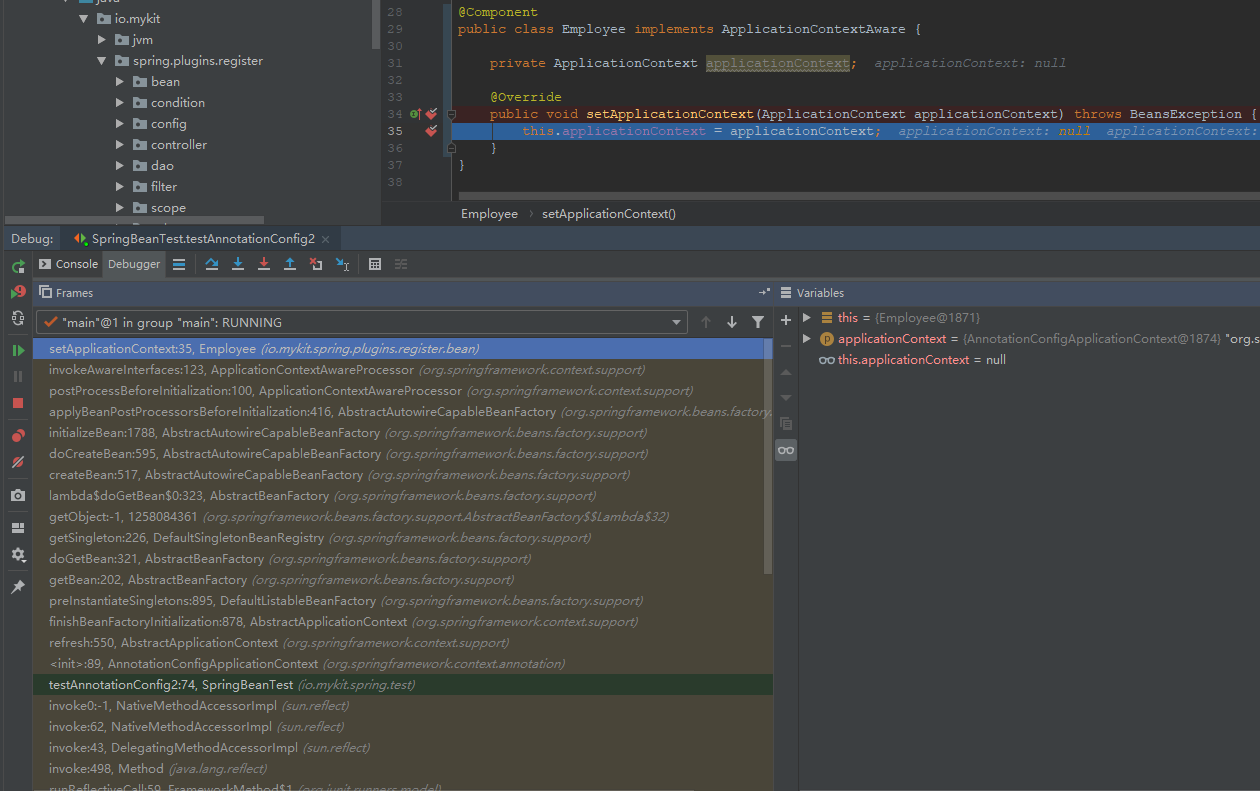
在IDEA的左下角可以看到方法的调用堆栈,通过对方法调用栈的分析,我们看到在执行Employee类中的setApplicationContext()方法之前,执行了ApplicationContextAwareProcessor类的invokeAwareInterfaces方法,如下所示。
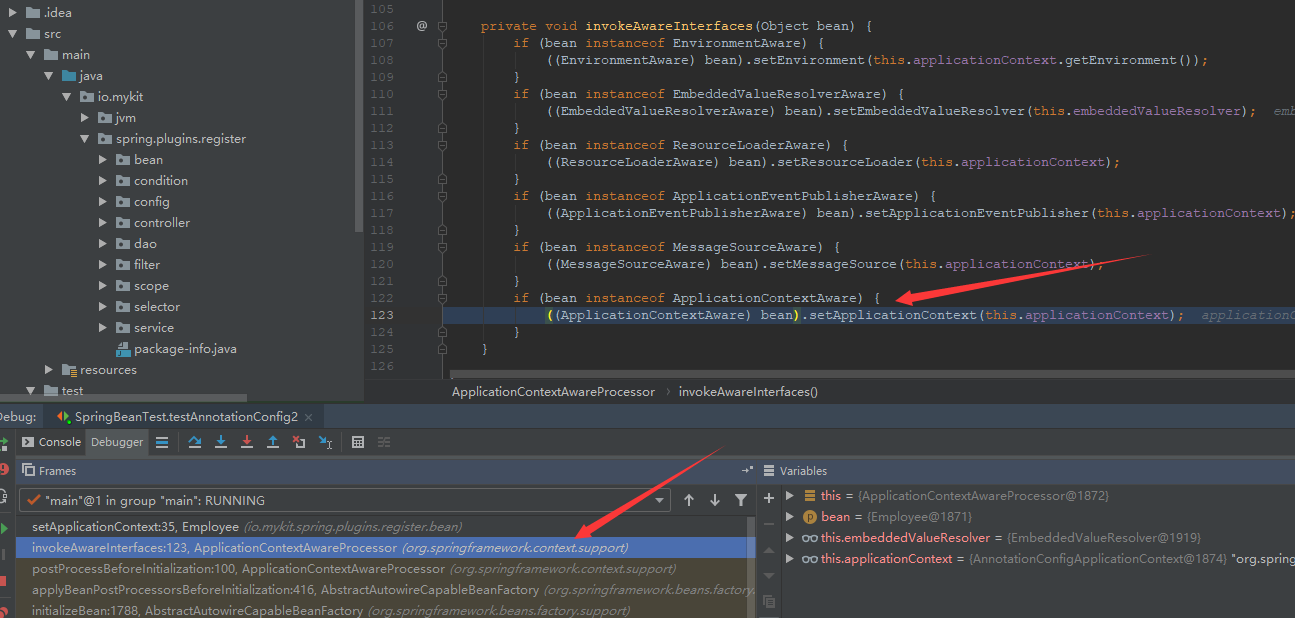
当我们点击方法调用栈中的invokeAwareInterfaces()方法时,代码的执行定位到如下一行代码。
((ApplicationContextAware) bean).setApplicationContext(this.applicationContext);
和我们之前分析的逻辑一致。
BeanValidationPostProcessor类
org.springframework.validation.beanvalidation.BeanValidationPostProcessor类主要是用来为bean进行校验操作,当我们创建bean,并为bean赋值后,我们可以通过BeanValidationPostProcessor类为bean进行校验操作。BeanValidationPostProcessor类的结构如下所示。
package org.springframework.validation.beanvalidation;
import java.util.Iterator;
import java.util.Set;
import javax.validation.ConstraintViolation;
import javax.validation.Validation;
import javax.validation.Validator;
import javax.validation.ValidatorFactory;
import org.springframework.aop.framework.AopProxyUtils;
import org.springframework.beans.BeansException;
import org.springframework.beans.factory.BeanInitializationException;
import org.springframework.beans.factory.InitializingBean;
import org.springframework.beans.factory.config.BeanPostProcessor;
import org.springframework.lang.Nullable;
import org.springframework.util.Assert;
public class BeanValidationPostProcessor implements BeanPostProcessor, InitializingBean {
/*******************************省略N行代码**********************************/
}
这里,我们也来看看postProcessBeforeInitialization()方法和postProcessAfterInitialization()方法的实现,如下所示。
@Override
public Object postProcessBeforeInitialization(Object bean, String beanName) throws BeansException {
if (!this.afterInitialization) {
doValidate(bean);
}
return bean;
}
@Override
public Object postProcessAfterInitialization(Object bean, String beanName) throws BeansException {
if (this.afterInitialization) {
doValidate(bean);
}
return bean;
}
可以看到,在postProcessBeforeInitialization()方法和postProcessAfterInitialization()方法中的主要逻辑都是调用doValidate()方法对bean进行校验,只不过在两个方法中都会对afterInitialization这个boolean类型的成员变量进行判断,如果afterInitialization的值为false,则在postProcessBeforeInitialization()方法中调用doValidate()方法对bean进行校验;如果afterInitialization的值为true,则在postProcessAfterInitialization()方法中调用doValidate()方法对bean进行校验。
InitDestroyAnnotationBeanPostProcessor类
org.springframework.beans.factory.annotation.InitDestroyAnnotationBeanPostProcessor类主要用来处理@PostConstruct注解和@PreDestroy注解。
例如,我们之前创建的Cat类中就使用了@PostConstruct注解和@PreDestroy注解,如下所示。
package io.mykit.spring.plugins.register.bean;
import javax.annotation.PostConstruct;
import javax.annotation.PreDestroy;
/**
* @author binghe
* @version 1.0.0
* @description 测试@PostConstruct注解和@PreDestroy注解
*/
public class Cat {
public Cat(){
System.out.println("Cat类的构造方法...");
}
public void init(){
System.out.println("Cat的init()方法...");
}
@PostConstruct
public void postConstruct(){
System.out.println("Cat的postConstruct()方法...");
}
@PreDestroy
public void preDestroy(){
System.out.println("Cat的preDestroy()方法...");
}
public void destroy(){
System.out.println("Cat的destroy()方法...");
}
}
那么,在Cat类中使用了 @PostConstruct注解和@PreDestroy注解来标注方法,Spring怎么就知道什么时候执行 @PostConstruct注解标注的方法,什么时候执行@PreDestroy标注的方法呢?这就要归功于InitDestroyAnnotationBeanPostProcessor类的实现了。
接下来,我们也通过Debug的方式来跟进下代码的执行流程。首先,在Cat类的postConstruct()方法上打上断点,如下所示。
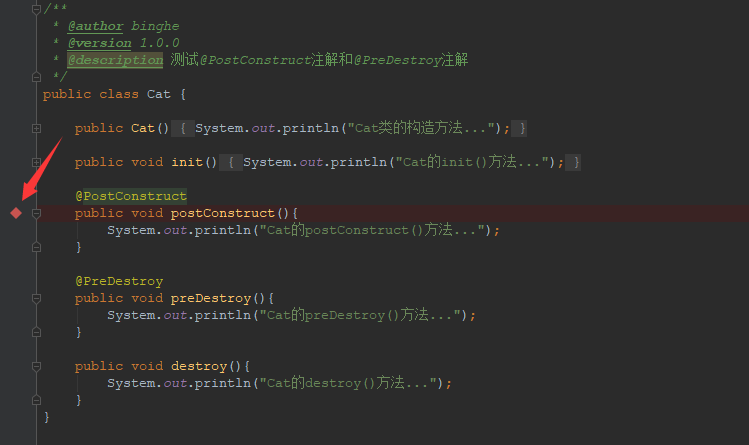
接下来,我们以Debug的方式运行BeanLifeCircleTest类的testBeanLifeCircle04()方法,效果如下所示。
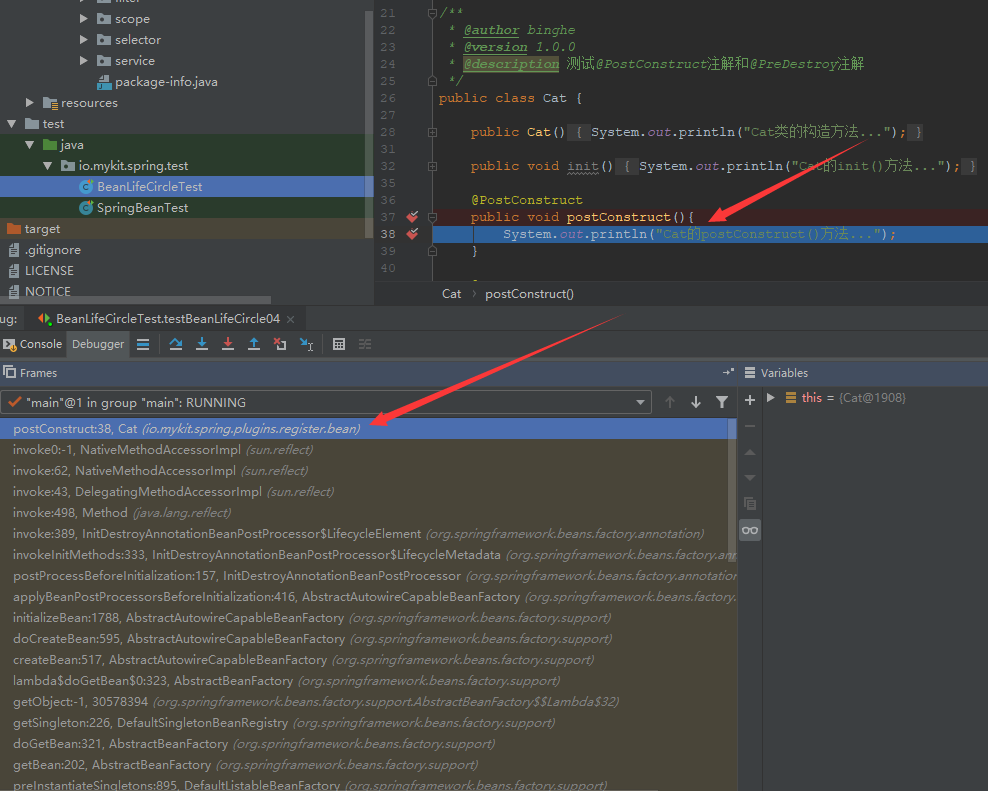
我们还是带着问题来分析,Spring怎么就能定位到使用@PostConstruct注解标注的方法呢?通过分析方法的调用栈我们发现了在进入使用@PostConstruct注解标注的方法之前,Spring调用了InitDestroyAnnotationBeanPostProcessor类的postProcessBeforeInitialization()方法,如下所示。
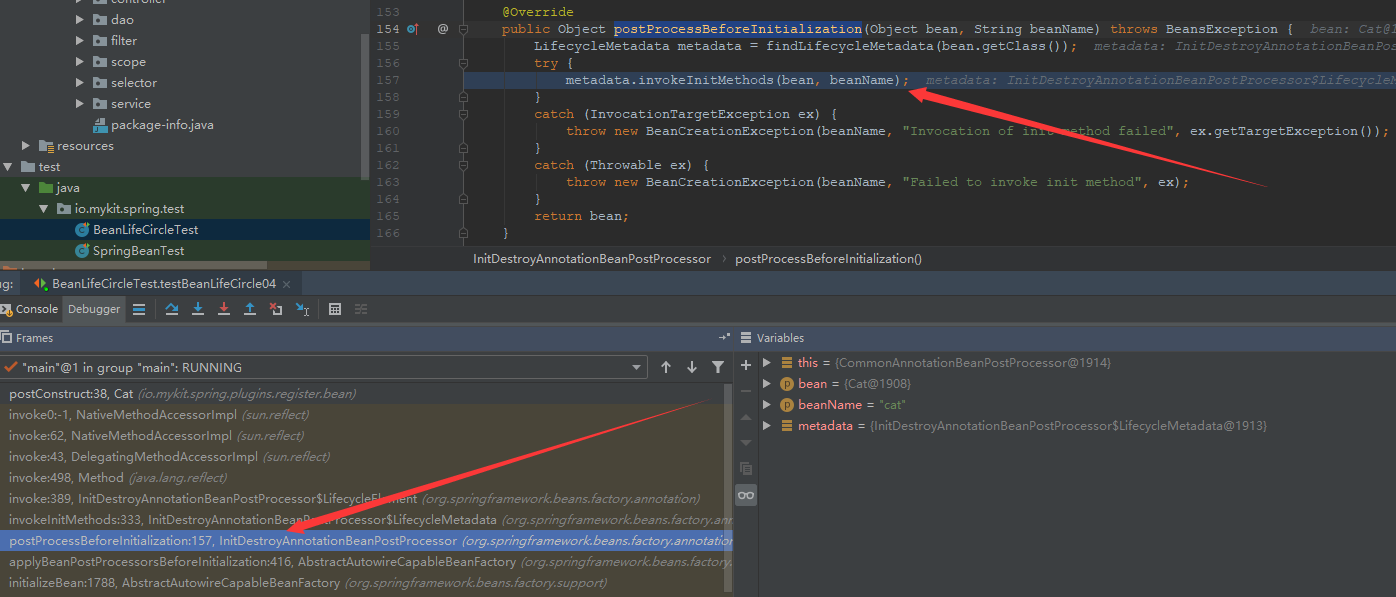
在InitDestroyAnnotationBeanPostProcessor类的postProcessBeforeInitialization()方法中,首先会找到bean中有关生命周期的注解,比如@PostConstruct注解等,找到这些注解之后,则将这些信息赋值给LifecycleMetadata类型的变量metadata,之后调用metadata的invokeInitMethods()方法,通过反射来调用标注了@PostConstruct注解的方法。这就是为什么标注了@PostConstruct注解的方法被Spring执行。
AutowiredAnnotationBeanPostProcessor类
org.springframework.beans.factory.annotation.AutowiredAnnotationBeanPostProcessor类主要是用于处理标注了@Autowired注解的变量或方法。
Spring为何能够自动处理标注了@Autowired注解的变量或方法,就交给小伙伴们自行分析了。大家可以写一个测试方法并通过方法调用堆栈来分析AutowiredAnnotationBeanPostProcessor类的源码,从而找到自己想要的答案。
好了,咱们今天就聊到这儿吧!别忘了给个在看和转发,让更多的人看到,一起学习一起进步!!
项目工程源码已经提交到GitHub:https://github.com/sunshinelyz/spring-annotation
写在最后
如果觉得文章对你有点帮助,请微信搜索并关注「 冰河技术 」微信公众号,跟冰河学习Spring注解驱动开发。公众号回复“spring注解”关键字,领取Spring注解驱动开发核心知识图,让Spring注解驱动开发不再迷茫。
最新文章
- asp.net 基礎部分一
- SQL Azure (16) 创建PaaS SQL Azure V12数据库
- js中 javascript:void(0) 用法详解
- C# Math类简介
- Monyer's game Google Hack关的BT玩法
- 深入理解计算机系统第二版习题解答CSAPP 2.8
- bzoj 2806: [Ctsc2012]Cheat 后缀自动机DP
- 在ie中用滤镜 (filter:progid:DXImageTransform.Microsoft.gradient)会触发overflow:hidden?
- 数据结构——bitmap
- Core Data & MagicalRecord
- Struts2之环境配置
- 第23篇 js快速学习知识
- 21. leetcode 492
- java 基础三
- 微信小程序实战--集阅读与电影于一体的小程序项目(一)
- js 颜色16进制转RGB方法
- ansible 问题
- 百度地图api---实现新建地图
- 关于使用Iscroll.js异步加载数据后不能滑动到最底端的问题解决方案
- ASP.NET Core Token认证